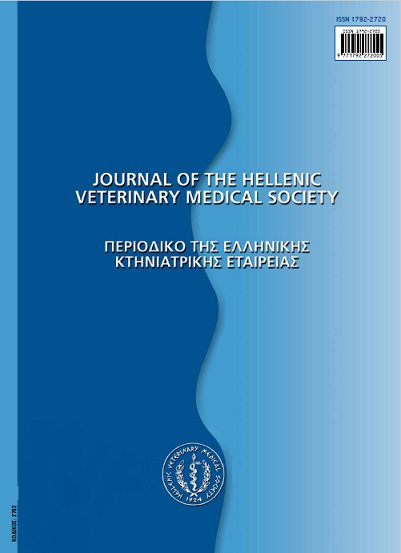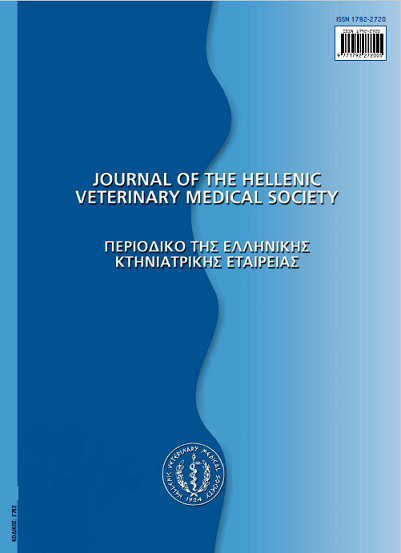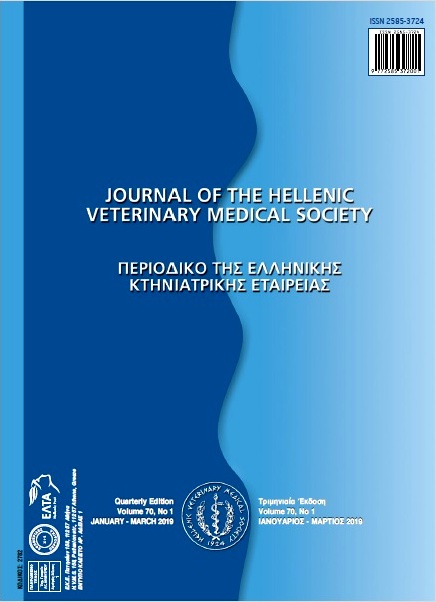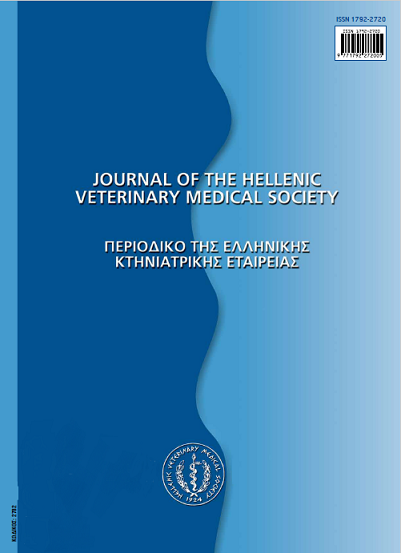Ρυθμός μείωσης του αριθμού αυγών των νηματωδών παρασίτων και της εξέλιξης των προνυμφών τους στο τρίτο στάδιο σε κόπρανα προβάτων και αιγών που συντηρούνται στους 4οC

Περίληψη
Ο γαστρεντερικός παρασιτισμός προκαλεί σημαντικές απώλειες παραγωγής στα μικρά μηρυκαστικά. Ο συχνότερος τρόπος διάγνωσης ή παρακολούθησης του επιπέδου παρασιτισμού στα πρόβατα και τις αίγες είναι οι ποσοτικές παρασιτολογικές εξετάσεις κοπράνων. Ωστόσο, η αξιοπιστία των μεθόδων αυτών βασίζεται κατά πολύ στις συνθήκες και τη διάρκεια αποθήκευσης των κοπράνων πριν την εξέταση. Ο σκοπός της παρούσας έρευνας ήταν η αξιολόγηση του ρυθμού απώλειας των αυγών και ο καθορισμός του μεγίστου χρόνου συντήρησης των κοπράνων στους 4oC χωρίς σημαντικές τέτοιες απώλειες. Επίσης, ο καθορισμός του μέγιστου χρόνου συντήρησης των κοπράνων χωρίς σημαντική επίδραση στην εξέλιξη των προνυμφών στο 3ο (μολύνον) στάδιο. Για το σκοπό αυτό συλλέχθηκε ένα ομαδικό δείγμα κοπράνων, ξεχωριστάγια πρόβατα και αίγες, από φυσικώς μολυσμένα μικρά μηρυκαστικά. Τα κόπρανα εξετάσθηκαν φρέσκα κατά την ημέρα της συλλογής τους και σε εβδομαδιαία χρονικά διαστήματα, κατά τη συντήρησή τους στους 4oC, έως 119 ημέρες μετά τη συλλογή τους. Ταυτόχρονα μέρος των κοπράνων, τις ίδιες χρονικές στιγμές με την ποσοτική εξέταση για αυγά, καλλιεργούνταν για την εκκόλαψη και εξέλιξη των προνυμφών στο 3ο (μολύνον) στάδιο. Διαπιστώθηκε ότι η συντήρηση των κοπράνων απόπρόβατα και αίγες στους 4oC, για παράδειγμα στο ψυγείο, όταν προορίζονται για παρασιτολογικές εξετάσεις εγκυμονεί κινδύνους λανθασμένης διάγνωσης, εάν δεν πραγματοποιούνται σε χρονικό διάστημα το οποίο δεν υπερβαίνει τις 3 εβδομάδες. Ο ρυθμός της απώλειας των αυγών των παρασίτων στα κόπρανα αρχίζει να γίνεται σημαντικά χαμηλότερος συγκριτικά με τα φρέσκα δείγματα, μετά την 3η εβδομάδα συντήρησης στους 4oC. Το ποσοστό της εξέλιξης των προνυμφών στο 3ο στάδιο μεταβάλλεται σημαντικά για το γένος Haemonchus αμέσως μετά την πρώτη εβδομάδα συντήρησης των κοπράνων (p<0,05).
Λεπτομέρειες άρθρου
- Πώς να δημιουργήσετε Αναφορές
-
DRIMTZIA, A., & PAPADOPOULOS, E. (2018). Ρυθμός μείωσης του αριθμού αυγών των νηματωδών παρασίτων και της εξέλιξης των προνυμφών τους στο τρίτο στάδιο σε κόπρανα προβάτων και αιγών που συντηρούνται στους 4οC. Περιοδικό της Ελληνικής Κτηνιατρικής Εταιρείας, 67(3), 177–182. https://doi.org/10.12681/jhvms.15636
- Τεύχος
- Τόμ. 67 Αρ. 3 (2016)
- Ενότητα
- Research Articles

Αυτή η εργασία είναι αδειοδοτημένη υπό το CC Αναφορά Δημιουργού – Μη Εμπορική Χρήση 4.0.
Οι συγγραφείς των άρθρων που δημοσιεύονται στο περιοδικό διατηρούν τα δικαιώματα πνευματικής ιδιοκτησίας επί των άρθρων τους, δίνοντας στο περιοδικό το δικαίωμα της πρώτης δημοσίευσης.
Άρθρα που δημοσιεύονται στο περιοδικό διατίθενται με άδεια Creative Commons 4.0 Non Commercial και σύμφωνα με την άδεια μπορούν να χρησιμοποιούνται ελεύθερα, με αναφορά στο/στη συγγραφέα και στην πρώτη δημοσίευση για μη κερδοσκοπικούς σκοπούς.
Οι συγγραφείς μπορούν να καταθέσουν το άρθρο σε ιδρυματικό ή άλλο αποθετήριο ή/και να το δημοσιεύσουν σε άλλη έκδοση, με υποχρεωτική την αναφορά πρώτης δημοσίευσης στο J Hellenic Vet Med Soc
Οι συγγραφείς ενθαρρύνονται να καταθέσουν σε αποθετήριο ή να δημοσιεύσουν την εργασία τους στο διαδίκτυο πριν ή κατά τη διαδικασία υποβολής και αξιολόγησής της.







